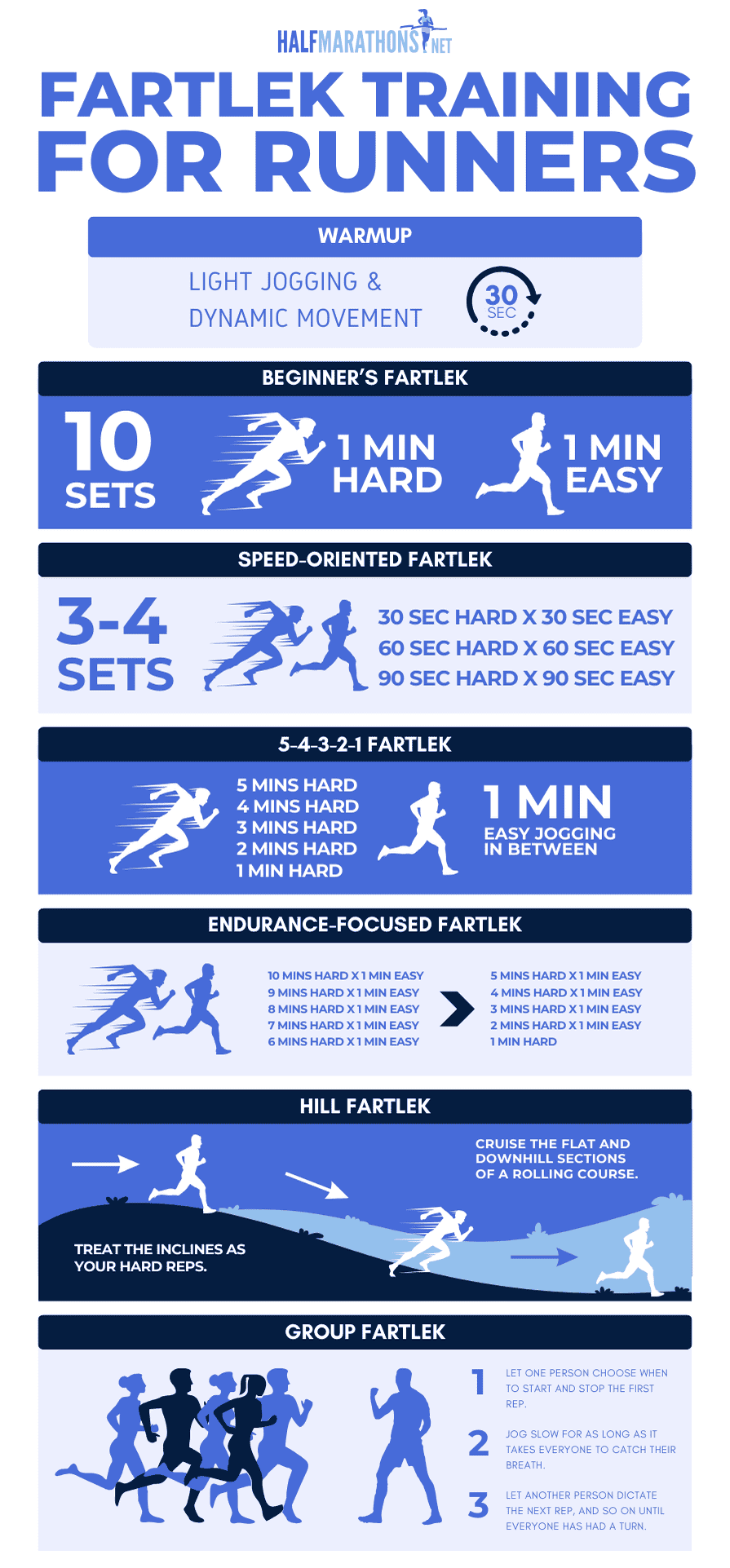As a long-distance runner, you may be familiar with training sessions such as mile repeats, tempo runs, and hill charges. But have you ever mixed things up with a fartlek workout? Whether you’re looking to improve how fast you run or break out of a training rut, adding fartlek sessions to your training regimen may be your ticket.
As a long-time and pro runner, I’ve utilized fartlek training at every stage of my running career, from high school cross country and track all the way up to professional marathoning. As a high school running coach, I also assign fartlek runs to my athletes at least a handful of times every season.
It’s a versatile training method that fits into any training plan and offers benefits to runners of all specialties and fitness levels.

What Is Fartlek Training?
Fartlek is a Swedish word that means “speed play.” Fartlek training refers to a type of running workout that’s dictated by effort rather than pace or distance.
A fartlek run blends faster paces with slower paces. But unlike traditional interval training, it’s also continuous meaning there’s no stopping between the hard segments. As a result, fartlek runs can be classified as both endurance and speed training.
Fartlek workouts come in two flavors:
- Structured: E.g. 5-4-3-2-1 fartlek, featuring 5 minutes, 4 minutes, 3 minutes, 2 minutes, and 1 minute of hard running, with around 1 minute of easy jogging in between
- Unstructured: E.g., Run hard to the nearest lamp post or telephone pole, then do an easy jog until you reach the next marker. Pick up the pace to the next one, and so on, for whatever total distance or time suits you.
Why Is Fartlek Training Good for Runners?
Fartlek training can make you a better runner in a number of ways. It’s great for:
1. Endurance and speed development
Fartlek workouts are an efficient way to boost fitness. That’s largely because they incorporate both endurance and speed work in a single session. If you run sufficiently hard, the fast pace will tax your anaerobic system. Meanwhile, the recovery jogs help build endurance since you don’t have the luxury of taking a break between hard efforts. Over time, this helps you to run more efficiently.
2. Race pace practice
Fartlek workouts are highly relevant to competition. In a fartlek, you’re practicing pace fluctuation. This helps prepare you to:
- Respond to any surges your competitors make
- To make such surges yourself
- To mentally tackle a long distance by breaking it up into chunks while staying present in the chunk that you’re in
- Set a good running pace for yourself in different segments

3. Training consistency
Some workouts, such as 10 x 400 meters or 3 x 2 miles, are best done in a controlled environment. You need a track or a well-paved, low-trafficked road.
By contrast, fartlek workouts can be done just about anywhere: a dirt road, sidewalk, single-track trail, 400-meter track, treadmill, or neighborhood loop. This helps you maintain training consistency.
4. Training in any conditions
Fartlek sessions are also great because they can be executed in any condition that’s safe to run in: spitting rain, blazing heat, or gnarly wind. Fartleks are all about effort and total workload, rather than pace or distance. If you really want to track something, heart rate is the one metric you can use to make sure you’re working in the appropriate zone(s).
5. Avoiding mental burnout
This is the reason I’ve kept fartlek training in my back pocket for so long: While traditional workouts which are all about splits, fartleks are low-feedback sessions that require hard work — but which you’ll feel good about no matter what. After all, a fartlek is supposed to feel like play!
I especially love incorporating fartlek sessions:
- In the early stages of a training plan
- While traveling or running somewhere unfamiliar
- When the weather is extreme
- While recovering from a race or monster workout

Who Should Be Doing Fartlek Training?
If you’re a distance runner, you should add fartlek training to your routine. Wherever you’re starting and whatever you’re training for, fartleks can help you reach your goals. That includes:
- Beginner runners
- Veteran runners
- One-mile runners
- Ultra-marathoners
And everything in between!
Fartleks are completely customizable based on your current fitness level, training environment, race distance, and goal race pace.
If you’re a mile specialist, for example, you may choose to run fartleks with shorter hard effort segments (between 30 seconds and 2 minutes, perhaps) and a shorter overall duration (such as 5K).
If you’re training for a half marathon, you can run a fartlek that spans roughly 10 miles and features longer stretches of faster running (like 10 minutes or even a little longer).
Fartleks vs. Other Speed Workouts
While some people consider fartleks a type of speed training, they do differ from traditional speed workouts in a few key ways:
- Recovery between intervals: Speed training usually includes standing or walking recoveries between hard efforts. Fartleks are continuous, with jogging recoveries but no stopping.
- Distance vs. time: Classic speed training has set interval distances, with some sort of goal pace or split for each. Fartleks have set intervals of time, but then the distance, splits, and pace are all variable.
- Location: Speedwork is often easiest to complete on a track, but you can run a fartlek anywhere without impacting the outcome.

How to do a Fartlek Workout
Before you begin a fartlek workout, warm up with:
- A 1-plus mile run
- Your usual stretches and/or drills for a hard sessions
- A few hard warm-up strides (e.g., 4-6 x 100m or ~18-second strides, with 30-60 seconds recovery time between each one).
Then it’s fartlek time. Whether you prefer the structured or unstructured variety, you’ll:
- Start off with a fast running pace.
- Maintain it until a landmark or timer indicates that it’s time to…
- Recover with a slow jog.
- Continue alternating between fast and slow paces until you reach the conclusion of the workout.
Keep in mind:
- Shorter segments (a minute or less) should feel more like a sprint, whereas longer ones (several minutes or so) should still feel hard but be at a strong but steady pace.
- For the recovery, slow down enough so you’re still moving forward but at a noticeably slower speed.
- The slower your recovery jog, the faster your hard intervals can be, so take the easy parts easy and make the hard ones count.
- The goal is to run the whole workout hard enough so you’re thoroughly spent — but not maxed out — by the end.
Afterwards, don’t forget to cool down with another easy 1-mile run or so.
How Hard Should You Run a Fartlek?
How hard any particular fartlek should be depends on:
- The duration of the faster segments
- The duration of the workout as a whole
If your hard efforts are 1 minute or shorter, you should treat them more like sprints than if they’re a few minutes or longer.
With longer reps, you’ll have to dial back the high intensity so you’re running at a hard but also sustainable pace.
Likewise, if the whole workout is on the shorter side (less than a half hour), you’ll be able to hit the hard parts harder than if it’s substantially longer.
In general, I encourage runners to at least touch race pace or effort in a fartlek. You can even quicker than that in the shorter reps. Since pace isn’t the goal here, go by feel rather than by the clock.
Keep in mind, the more fartlek workouts you run, the better tuned into your body and different paces you’ll be.

The Best Fartlek Workouts for Runners
Because fartlek’s are so open-ended, there are endless ways to go about a fartlek workout. Here are some of my favorite fartleks that I used in my own training and in that of my athletes:
- Beginner’s Fartlek: 10 sets of 1 minute hard x 1 minute easy
- 5-4-3-2-1 Fartlek: Hard running for 5 minutes, 4 minutes, 3 minutes, 2 minutes, and 1 minute, with 1 minute of easy jogging in between.
- Speed-Oriented Fartlek: 3-4 sets of 30 seconds hard x 30 seconds easy; 60 seconds hard x 60 seconds easy; 90 seconds hard x 90 seconds easy
- Endurance-Focused Fartlek: 10 minutes hard x 1 minute easy; 9 minutes hard x 1 minute easy; 8 minutes hard x 1 minute easy; 7 minutes hard x 1 minute easy; 6 minutes hard x 1 minute easy; 5 minutes hard x 1 minute easy; 4 minutes hard x 1 minute easy; 3 minutes hard x 1 minute easy; 2 minutes hard x 1 minute easy; 1 minute hard
- Hill Fartlek: Cruise the flat and downhill sections of a rolling course, and treat the inclines as your hard reps
- Group Fartlek





